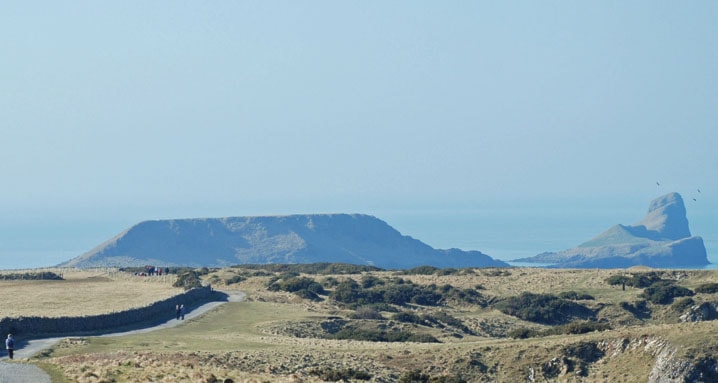Sometimes timing is everything. This is particularly true for those who wish to hike to Worm’s Head, a famous promontory on the most westerly tip of the Gower Peninsula in Wales, U.K.
The serpent-shaped land mass known as Worm’s Head is joined to the mainland by a rocky causeway that is only exposed for two and a half hours before and after low tide. Many inexperienced hikers have found themselves trapped on the Worm when they miscalculated the tides. Legend has it that Wales’ most famous poet, Dylan Thomas, got trapped on the windswept island more than once. The first time was an accident, but the second time he was accompanied by a young lady and some thought his miscalculation of the tides to be a little too convenient to be considered accidental.
The Gower peninsula is one of the most stunning coastlines in the U.K. and Dylan Thomas is not the only poet to find his muse while wandering along its windy cliffs. So famed is this coastline that the Royal Mint created a silver £5 coin depicting Worm’s Head to commemorate the London 2012 Olympics and the places, people and history of the nation.
The Old Rectory that sits along the peninsula is the most popular holiday cottage operated by the National Trust and a visit to the cottage makes it easy to imagine this coastline during the era of Dylan Thomas.
Outside the front gate of the Rectory is a commanding view of Rhossili Bay with its expansive sandy beach.
At low tide you can see the remains of Helvita, a ship that wrecked in 1887. A paved path leads along the grassy cliff top to a lookout where you can take in a view that encompasses much of this wild coastline. If you follow it far enough and if you arrive at low tide, the path will take you to the rocky causeway that leads to Worm’s Head.
As I stood at the lookout on the peninsula, I realized that my timing had been a little off. If I had come a few hours earlier, I might have been able to hike all the way to Worm’s Head. As it was, I had to settle with a walk along the cliff tops and a view of the Worm from the old lookout.
It’s easy to see why this peninsula and its beautiful coast are so beloved in the U.K. As I gazed across the submerged causeway at the famous Worm’s Head, I promised myself to return one day at low tide and complete the hike.
The legend of Swansea Jack
Swansea Jack was a black dog (most likely a flat coated retriever) that became famous for rescuing people from the River Tawe and the docks of Swansea, Wales.
Jack lived with his master William Thomas near the North Dock area of Swansea. Although he was never trained as a rescue dog, Jack would always respond to a cry for help.
His first rescue of a 12-year-old boy in July 1931 went unnoticed, but his second rescue a few weeks later was performed in front of a crowd.
In his lifetime, Swansea Jack is credited with saving a total of 27 people from drowning and was awarded the “Bravest Dog of the Year” by the London Star. He is the only dog to ever have been awarded two bronze medals by the Canine National Defence League. In 2000, Swansea Jack was named dog of the century by NewFound Friends of Bristol, an organization that trains domestic dogs in aquatic rescue techniques.
A statue of Swansea Jack is located on the Promenade in Swansea. There is also a pub and a football team named for this beloved canine.
Where to stay
The Gower Peninsula can be explored from the City of Swansea, but a country inn outside the city provides the opportunity to enjoy the wonderfully varied and picturesque landscapes that Wales is famous for.
The country inns that belong to the Welsh Rarebits organization (www.rarebits.co.uk) are always a good bet, because they have to achieve a certain standard of cuisine and scenery.
Debbie Olsen is a Lacombe-based freelance writer. If you have a travel story you would like to share or know someone with an interesting travel story who we might interview, please email: DOGO@telusplanet.net or write to: Debbie Olsen, c/o Red Deer Advocate, 2950 Bremner Ave., Red Deer, Alta., T4R 1M9.
